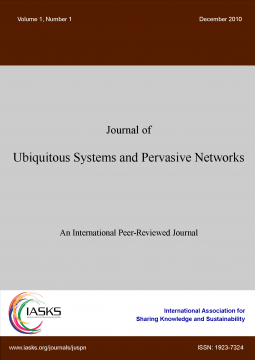volume-06
Latest Articles
End-to-End Safety Solution for Children Enabled by a Wearable Sensor Vest
JUSPN, volume-06 , Issue 1 (2015), PP 33 - 39
Published: 20 Feb 2015
DOI: 10.5383/JUSPN.06.01.005
by Mirjami Jutila, Pekka Karhula, Helena Rivas , Susanna Pantsar-Syväniemi from VTT Technical Research Centre of Finland, Oulu, 90571, Finland
Abstract: Mobile and wearable sensors are increasingly becoming an important part of our lives in securing everyday actions, monitoring and controlling our health and well-being. This paper presents an end-to-end safety service for parents and teachers in day-care centers and schools, including a prototype wearable vest with various sensors monitoring the environment and presence of children. Teachers and parents are able to receive alerts and notifications, e.g., when a child moves across certain restricted outdoor or indoor area, through gateways that have connectivity to server or cloud. All the information gathered by the vest is made available utilizing Sensor Web Enablement (SWE) services to guarantee a standardized way to manage the data coming from multiple sources. The vest is part of a larger framework to provide digital safety applications and services through various sensor devices. read more... read less...
Keywords: Wearable Computing, Safety, Children, Sensor, LilyPad Arduino, Adafruit Flora, Sensor Web Enablement
LOS/NLOS Identification Based on Stable Distribution Feature Extraction and SVM Classifier for UWB On-Body Communications
JUSPN, volume-06 , Issue 1 (2015), PP 27 - 32
Published: 15 Feb 2015
DOI: 10.5383/JUSPN.06.01.004
by Mohamed Tabaa, Camille Diou , Rachid Saadane, Abbas Dandache from Ecole Marocaine des Sciences de l'Ingénieur (EMSI), Département Recherche & Innovation, Casablanca, Maroc Laboratoire de Conception, Optimisation et Modélisation des Systèmes (LCOMS), équipe Architecture des systèmes Embarqués et Capteurs intelligents (ASEC), Université de Lorraine, Metz, France c Ecole Hassania des Travaux Publics (EHTP), Casablanca, Maroc
Abstract: This paper presents a technique for identifying between both Line-Of-Sight (LOS) and Non-Line-Of-Sight (NLOS) propagation schemes for UWB on-body context. In the last few years, a great attention has been paid to wireless communications for body area networks especially since the IEEE 802.15.6 standard has been released. We focus at first to extract only the pertinent information using Stable Distribution compared with statistical techniques, and secondly to classify it using Support Vector Machine (SVM) with as main goal to identify between the two LOS and NLOS phenomena. We propose a technique to make the classification easy between LOS and NLOS contexts for UWB on-body communications. Our approach gives a good recognition rate of 87.5%, better than other methods in the same context. read more... read less...
Keywords: Ultra-wideband (UWB), Line-of-sight (LOS), Non-line-of-sight (NLOS), Stable distribution, Support Vector Machine (SVM), On-body communications.
Support Vector Machines Regression for Channel Estimation in MIMO LTE systems
JUSPN, volume-06 , Issue 1 (2015), PP 11 - 16
Published: 29 Dec 2014
DOI: 10.5383/juspn.06.01.002
by Anis Charrada, Abdelaziz Samet from Tunisia Polytechnic School, University of Carthage, Box 743 - 2078 La Marsa, Tunisia INRS, EMT Center, 800 de la Gauchetière W., Suite 6900, Montreal, QC, H5A 1K6, CANADA
Abstract: This paper proposes an efficient scheme to track the time variant channel induced by multipath fading wireless Multiple-Input Multiple-Output Orthogonal Frequency Division Multiplexing (MIMO-OFDM) system in mobility environment with the presence of Gaussian noise. The estimation of the time varying multipath fading channel is performed by using a nonlinear channel estimator based on a complex Multiple Support Vector Machines Regression (M-SVR) which is developed and applied to MIMO Long Term Evolution (LTE) Downlink with Alamouti coding. The obtained results confirm the effectiveness of the proposed technique to track the fading channel compared to the conventional Least Squares (LS), Minimum Mean Squares Error (MMSE) and Decision Feedback methods. read more... read less...
Keywords: Complex M-SVR, MIMO, OFDM, Alamouti coding and LTE.
Personal Mobile Grids: Ubiquitous Grid Environments For Personal Users
JUSPN, volume-06 , Issue 1 (2015), PP 01 - 10
Published: 15 Feb 2015
DOI: 10.5383/JUSPN.06.01.001
by Heba Kurdi from King Saud University, Riyadh , SA, 11432
Abstract: The overall aim of this paper is to introduce Personal Mobile Grids (PM-Grids) as a novel paradigm in grid computing that eases scaling grid infrastructures to mobile devices and extending grid users to individuals outside research and enterprise domains. In this paper, architectural designs and simulation models for PM-Grids are presented as well as a honeybee inspired resource scheduling heuristic incorporating a radical approach to grid schedulers. A detailed design and implementation of Hope with a decentralized self-management and adaptive policy are presented. PM-Grid designs and Hope implementation were evaluated thoroughly through a strictly controlled empirical evaluation framework with a well-established heuristic in high throughput computing, the opportunistic scheduling heuristic (OSH), as a benchmark algorithm. Experimental results demonstrated the superiority of Hope performance in terms of stability, throughput and turnaround time, under different running conditions of number of jobs and grid scales. read more... read less...
Keywords: Distributed networks, Mobile Computing Architectures, Mobile environments, Ubiquitous computing

